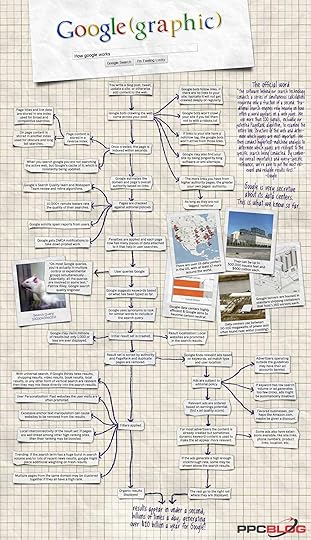Doris-Maria Heilmann's Blog, page 84
June 7, 2013
ISBN Numbers and How to Get One
.
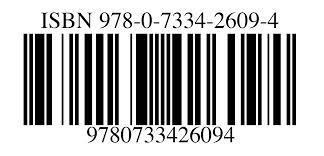
ISBN
.
Selling your e-book on Amazon, Barnes&Noble, Apple or Kobo doesn’t necessarily require an ISBN, but it will be necessary, as soon as you start your books print version. Any book on your book shelf, library or in book stores has an ISBN.
ISBN is the International Standard Book Number, a 13-digit number that uniquely identifies books published anywhere in the world. Parts of an ISBN are:
group or country identified
publisher identifier
title identifier
and the check digit
ISBN numbers are assigned by a group of agencies worldwide coordinated by the International ISBN Agency in London, England. In the United States, ISBN’s are assigned by the U.S. ISBN Agency: R.R. Bowker is the independent agent in the US for this system. You can order an ISBN online – or even better, a block of ten. On average it takes about two weeks for ISBN’s to be assigned. In addition to their ISBN prefixes, every publisher can also register their titles for free with Bowker to be included in the “Books In Print” worldwide databases. See also a former blog post here on this site:
http://savvybookwriters.wordpress.com/2011/08/31/important-expose-your-book-to-the-world/
.
Author Beware:
You may encounter offers from other sources to purchase single ISBN’s at special offer prices. Companies that provide limited services such as distributing, retailing, bar code services, printing, such as aggregators or print-on-demand companies, should NOT assign ISBN’s from their company to your publications – unless you allow them to also hold the publishing rights. If you use one of these reassigned ISBN’s, you will NOT be correctly identified as the publisher. The result may be extensive costs to apply for a new ISBN and the application of stickers to books already printed and in circulation. Remember: The one who ordered the ISBN from the official agency is listed as the publisher!
.
ISBN’s are assigned to publishers as follows: 1, 10, 100, or 1,000 numbers. The publisher registration fee is US $24.95 plus a service fee that starts at $250.00 for 10 ISBN’s. There’s also a $25 annual fee for each publisher, so whether you have one ISBN or a thousand, you’ll have to pay that additional amount too. For a new publisher to get an ISBN – or better ten – will cost (in 2013) US $250 (or US $25 per ISBN). Since you can get 10 ISBN’s for the same price as one, it is worth applying for books you have in mind too, rather than just the one you are right now going to publish. You can also get the bar code for your book from Bowker.
.
Bar codes
ISBN’s are emailed to publishers. Once a publisher has been assigned ISBN’s, they should be placed on the copyright page, encoded on the bar code, and the bar code placed on the back cover of the book. When a title is ready to be sold, it can be registered at “Books in Print” a worldwide book registry. “Books in Print” is the main directory that bookstores, online retailers, and libraries use when looking for books for their customers.
.
Where to order ISBN’s in major English-speaking countries:
USA
http://www.isbn.org/standards/home/isbn/us/secureapp.asp
see prices above
United Kingdom & Ireland
http://www.isbn.nielsenbook.co.uk/controller.php?page=121
10 ISBN = £118.68
Australia
http://www.thorpe.com.au/isbn/
Single ISBN=Australian $40.00 and a block of 10 ISBNs=$80.00
Canada
http://www.collectionscanada.gc.ca/ciss-ssci/041002-2000-e.html
Good news for Canadian authors and publishers: the ISBN application process is simple and free of charge – but only if you are living in Canada and your publishing company is registered in Canada. For all other countries check out the worldwide listing at “National ISBN Agencies“.
.
<><><><><>
.
If you would like to get help in all things publishing, have your book heavily promoted and learn how to navigate social media sites: We offer all this and more for only a “token” of $1 / day for 3 months. Learn more about this individual book marketing help: http://www.111Publishing.com/seminar
Please feel free to check out all previous posts of this blog (there are 770 of them : ) if you haven’t already. Why not sign up to receive them regularly by email? Just click on “Follow” in the upper line on each page – and then on “LIKE” next to it. There is also the “SHARE” button underneath each article where you can submit the article to Pinterest, Google+, Twitter, Chime.in, Facebook, Tumblr and StumpleUpon.
Thanks a lot for following:
@111publishing
http://pinterest.com/111publishing/
http://bit.ly/VmtVAS 111Publishing @ Google+
.
Tagged: block of ISBN's, book industry database, Books in Print, Bowker, how to get an ISBN, ISBN number, publishing rights, who owns the ISBN







June 5, 2013
How to Get Freelance Writing Jobs for Airlines
.

– Airliner Dock
.
Making money with your first book is not very likely – at least not right away. From the second or third
book on it gets easier, but still it might take years – if ever – until you can make a living as an author.
Don’t get discouraged, there are lots of niches were you can earn faster money with your writing, compared to books: Writing for magazines. Especially airline magazines represent real opportunity for freelance writers. Despite contractions in the airline industry, in-flight magazines still attract many readers, and they are mostly written by freelancers.
.
Airline magazines
The best thing about writing for in-flight magazines is that each one is different. Some of them – such
as Sky for Delta Airlines – feature restaurant reviews, fiction stories, regular columns and technology
articles in addition to a cornucopia of other topics. Other inflight magazines are focused primarily on
travel, with in-depth articles on interesting destinations.
.
Bored at 36,000 feet
The readership of the in-flight magazine tends to be larger than those of regular consumer
magazines. Take for example just the Los Angeles to Singapore, Tokyo, Bangkok, Delhi and many
other flights on Singapore Airlines, with an immense number of passengers on every flight and the
number of daily flights going out from Los Angeles. There are potentially hundreds of thousands of
travelers reading your article every month.
However almost 50 passenger airlines fly in the U.S. alone — many are smaller regional and
commuter airlines — and they all have magazines on their planes. Southwest alone, claims 3.4
million readers per month of their in-flight magazine. Add to that the airlines in English-speaking
countries such as Canada, the UK / Ireland, Australia, India, South Africa – and the fact, that most
in-flight magazines worldwide are published in two languages, preferable in English as well. The in-flight magazine market is global. You need not limit yourself to North American publications.
.
Know the magazine inside out
Travel pieces are a staple of in-flights, yet airline publications also offer articles on technology,
business, sports, and food, as well as lifestyle trends. Find as much of the articles online. Or try to
get hard copies. Since in-flights are not sold on newsstands, request a copy from the magazine’s
publisher and ask traveling friends for their help
.
Know your audience
The trick to writing for in-flight magazines is knowing the target audience. The vast majority of
readers are frequent flyers – travelers and wealthy vacationers. They are also savvy about technology and business trends, as well as travel and leisure pursuits. Writing for in-flight magazine readers requires to cater to a well-educated, travel-savvy audience. These free magazines should reflect their interests: Profiles of successful business leaders, great restaurant trends, management and entrepreneur tips, descriptions of new gadgets for business people or travelers,etc. If you have experience in a particular facet of business that can be applied to travelers, turn that to your advantage.
.
Pay higher rates
Compared to consumer magazine publishers, in-flight magazines tend to pay a higher rate for freelancers. Excellent writers might earn up to $3.000 for a three page feature with photographs. Rates typically vary between $0.70 – $1.00 per word. Also, you’ll almost never get your name put with the article, at least you have it in your portfolio with – no proof you actually wrote it.
.
Learn how to break into this market
Airline magazines’ web sites don’t make the guidelines easy to find. You often have to dig deep into
their website. The common misperception is that this market is nearly impossible to break into. And,
in fact, if you’re only thinking about writing for the magazines in the seat pockets on United, Delta,
Continental, Northwest, American, and US Airways — and you’re just starting out freelance writing — you could find yourself a bit frustrated. In-flight magazines are not always very accepting of beginning writers. While they’re designed to appeal to all travelers, they do tend to cater to a more upscale market, and as such they demand top-notch writing and credentials. Writers with a limited portfolio will probably not be welcomed into the features section with open arms.
.
Some Tips before you query:
The aspiring freelance author must know and understand the magazine before querying. Read the magazine, their web sites often have archived copies to download, get to know their style.
Learn about the airlines’ customer demographics and include in your pitch why your story will appeal to them. Demographics can be found under the “advertising” section of the magazine’s web site.
Only propose stories on destinations served by the airline you are pitching
Pitch “evergreen” stories, or stories that allow for the magazines’ long lead times.
Start writing a travel blog with side topics, similar to those in airline magazines to see what it is like to write short pieces for an international audience.
Mention it, if you have high-quality accompanying photos in TIFF.
Check out the magazine’s editorial calendar, usually found under the “advertising” section on the web site.
In-flights receive many queries for travel pieces. It may be easier for a newcomer to break in by pitching an article on a business or service topic.
Pitch a specific column. You’ll be more likely to get an assignment if your pitch matches the magazine’s format . Many of the web sites list the specific departments for which the editors solicit submissions.
Keep your story short. Most pieces are 800 words or less; “features” usually run under 2,500 words.
Keep your articles positive, not challenging. In-flight magazines want to keep their readers relaxed and entertained.
In-flight magazine resources:
Air Canada
http://enroute.aircanada.com/en/magazine
British Airways
http://www.bahighlife.com/
Cathay Pacific
http://www.bauermedia.com.hk/
United
http://www.Hemispheres.com
WestJet
http://www.upmagazine.com/write-us
SkyWest (SkyWest Airlines)
http://www.skywestmagazine.com
Hana Hou! (Hawaiian Airlines)
http://www.hanahou.com
Cision Navigator lists the top-ten in-flight magazines by circulation:
A comprehensive list of 101 in-flight magazines from AirArabia to Wizz Air (many with links directly to
the magazine’s web site)
.
The in-flight magazine market is competitive, although not impossible to crack. Even if you don’t
have a long list of publication credits or an impressive resume, you can still break into the in-flight
market. Important: Do your research — both about your topic and the publication you are pitching,
rely on your particular expertise about a place or subject matter, and produce insightful, error-free
copy aimed at a sophisticated audience of frequent travelers.
.
<><><><><>
.
If you would like to get help in all things publishing, have your book heavily promoted and learn how to navigate social media sites: We offer all this and more for only a “token” of $1 / day for 3 months. Learn more about this individual book marketing help: http://www.111Publishing.com/seminar
Please feel free to check out all previous posts of this blog (there are 770 of them : ) if you haven’t already. Why not sign up to receive them regularly by email? Just click on “Follow” in the upper line on each page – and then on “LIKE” next to it. There is also the “SHARE” button underneath each article where you can submit the article to Pinterest, Google+, Twitter, Chime.in, Facebook, Tumblr and StumpleUpon.
Thanks a lot for following:
@111publishing
http://pinterest.com/111publishing/
http://bit.ly/VmtVAS 111Publishing @ Google+
.
Tagged: Air Canada, airline magazines, airline travelers, British Airways, Cathay Pazific, In-flight magazines, Skywest Airlines, WestJet







The Smartest Thing You Can Do Today

QueryShark
.
“The smartest thing you can do today for your career (other than write)”. This is the motto of an amazing blog that I just discovered: http://queryshark.blogspot.ca
You might have realized when reading my blog that I am a big fan of author-publishing and not very fond of traditional publishers. But not every author is entrepreneurial-minded or has not yet discovered that publishing houses require authors nowadays to be active on social media and that they have to promote their books themselves.
So, if an author wants to go the traditional route, it should be done professionally to avoid too many rejections and frustration. QueryShark seems to be a great help in writing pitches to agents or to trade publishers. Interesting tweets from their site: @QueryShark
.
How To Write Query Letters …
or, really, how to revise query letters so they actually work. Read the very detailed directions provided to authors on this site, AFTER you went through their other query critiques first! QueryShark is entirely volunteer. And no queries are posted unless the writer specifically asks the QueryShark to do so.
.
Query Shark critiques fiction queries.
You have to send a query to the shark for it to be considered. There is a checklist for how to do that on the post labeled “If You Want Your Query Posted, Read and FOLLOW These Directions”.
Don’t miss to read all the samples of queries that succeeded. Scroll down and find them on the left site of the QueryShark web page. Great samples of how to hook the interest of an agent or a traditional publisher and lots to learn from.
.
More on how to write a query letter – or not:
10 Dos and Don’ts of Writing a Query Letter
.
<><><><><>
If you would like to get help in all things publishing, have your book heavily promoted and learn how to navigate social media sites: We offer all this and more for only a “token” of $1 / day for 3 months. Learn more about this individual book marketing help: http://www.111Publishing.com/seminar
Please feel free to check out all previous posts of this blog (there are 770 of them : ) if you haven’t already. Why not sign up to receive them regularly by email? Just click on “Follow” in the upper line on each page – and then on “LIKE” next to it. There is also the “SHARE” button underneath each article where you can submit the article to Pinterest, Google+, Twitter, Chime.in, Facebook, Tumblr and StumpleUpon.
Thanks a lot for following:
@111publishing
http://pinterest.com/111publishing/
http://bit.ly/VmtVAS 111Publishing @ Google+
.
Tagged: agent query, How to Write a Query Letter, http://queryshark.blogspot.ca, query letter, query writing help, QueryShark







June 3, 2013
Ever Wondered How Google Works?
.
Everyone wants to be listed high on Google’s search engine results. You write a blog post, tweet, update your website or add otherwise content to the web. Google bots, crawling the web, are coming across your post. The page is indexed within seconds. Google estimates the domain and pages’ overall authority, based on links.
PageRank depends on a few factors:
The number of other Web pages that link to the page
The frequency and location of keywords within the Web page
How long the Web page has existed
To read more on the info-graphic, click on this PPC Blog:
http://www.ppcblog.com/how-google-works/
.
Infographic by PPCBlog
.
Jonathan Strickland wrote in an article: “What began as a project by Larry Page and Sergey Brin, two students in Stanford University’s Ph.D. program, is now one of the most influential companies on the World Wide Web: Google. At first, the students’ goal was to make an efficient search engine that gave users relevant links in response to search requests. While that’s still Google’s core purpose today, the company now provides services ranging from e-mail and document storage to productivity software and mobile phone operating systems. In less than a decade, Google evolved from a two-man enterprise to a multibillion-dollar corporation.”
.
<><><><><>
.
If you would like to get help in all things publishing, have your book heavily promoted and learn how to navigate social media sites: We offer all this and more for only a “token” of $1 / day for 3 months. Learn more about this individual book marketing help:
http://www.111Publishing.com/seminar
Please feel free to check out all previous posts of this blog (there are more than 765 of them : ) if you haven’t already. Why not sign up to receive them regularly by email? Just click on ”Follow” in the upper line on each page – and then on “LIKE” next to it. There is also the ”SHARE” button underneath each article where you can submit the article to Pinterest, Google+, Twitter, Chime.in, Facebook, Tumblr and StumpleUpon.
Thanks a lot for following:
Twitter: @111publishing
http://pinterest.com/111publishing/
http://bit.ly/VmtVAS 111Publishing @ Google+
.
Tagged: bots, crawling, Google algorithm, Google Search, Search Engine Optimization, SEO, synonyms







How to Choose the Right Genre for Your Book
.

Dandelions look all the same …
.
It can make all the difference… how well your book sells. Readers have to FIND your book to buy it. Before sending out queries to publishers or agents, study carefully which genres they prefer. There is a large list of possible categories to put your book in: the categories that best match your books based on their content. Study carefully each book that is competitive to yours and see in which categories the bestsellers among them are listed. Narrow down your list as much as possible.
.
Why are the proper categories so important, for example on Amazon?
Without the right categories you may never become a category bestseller and never gain the publicity needed for higher visibility, never be recognized by Amazon’s algorithms which gains you better rankings in the numerous other Amazon Top 100 lists, which in turn gains you higher visibility, higher rankings, which generates more…
.
Millions of books are being published in the world today.
Categorization of books by topic and content has become an important tool for readers to enable them to choose what they like to read. Readers, booksellers, publishers, and authors alike benefit from category descriptions for books, it is important for authors to determine the best genre or category to identify their book before publishing.
.
Comprehensive listing of genres can be found on the Internet:
A deep dive into sub-genres can be found at Paul Carlson’s blog post. Another great list can be found at Wikipedia.
.
List of fiction genres (but with extensive definitions):
www.manuslit.com/flash/index.html (under the “Info for Writers” section).
www.cuebon.com/ewriters/genres.html (click on definition and examples)
.
Science Fiction, Fantasy & Horror:
www.writing-world.com/romance/romgenres.shtml
.
Sub-genres of Romance:
www.bubblecow.net/a-list-of-book-genres
http://dannyreviews.com/subjects.html
http://home.comcast.net/~dwtaylor1/
.
According to Publishers Weekly, the most popular genres in e-book literature are:
Literary/Classic
Science Fiction
Romance
Mystery/Detective
General Fiction
Thriller
Young Adult
.
Amazon takes you right to a fiction page and the top-selling e-books …
It could take readers forever to find what they are looking for – unless they click on a GENRE link, which is called “Departments” and can be found on the left hand site of the page. However, you have to go to “Books”, clicking on “Kindle” doesn’t show any genres on the first page.
Study carefully each book that is competitive to yours and see in which categories the bestsellers among them are listed. Narrow down your list as much as possible. If your book is available both, in print and as an e-book on Amazon, you can choose four categories (two for print and two for digital) and see in which your book best fares.
Barnes&Noble does something similar, but their GENRE listings are more obvious and on the main page instead of just on a side menu.
.
Genres help to market to traditional publishers
Categorizing your book not only helps you to sharpen its position, but also to market it to publishers. Categorization enables you to send your inquiries to publishers and editors that specialize in your type of book and to mention the category in the first sentence of your query letter. As well as guiding you while writing, categorization also significantly improves your chances of acceptance by a publisher.
.
It can make all the difference …
On the other hand, publishers often lack to categorize their author’s books in the right sub-category.
I discovered this many times when evaluating our clients books, looking for the best category / sub-category. And it often takes a lot of time and convincing to have a publisher change the subcategory… Self-publishing authors don’t have this problem, they can change anything on their Amazon account in seconds. It can make all the difference, how well a book will sell. And how fast an author will get to the top of a certain category and becomes a bestseller in this category.
.
<><><><><>
.
If you would like to get help in all things publishing, have your book heavily promoted and learn how to navigate social media sites: We offer all this and more for only a “token” of $1 / day for 3 months. Learn more about this individual book marketing help: http://www.111Publishing.com/seminar
Please feel free to check out all previous posts of this blog (there are more than 760 of them : ) if you haven’t already. Why not sign up to receive them regularly by email? Just click on “Follow” in the upper line on each page – and then on “LIKE” next to it. There is also the “SHARE” button underneath each article where you can submit the article to Pinterest, Google+, Twitter, Chime.in, Facebook, Tumblr and StumpleUpon.
Thanks a lot for following:
@111publishing
http://pinterest.com/111publishing/
http://bit.ly/VmtVAS 111Publishing @ Google+
.
Tagged: Amazon bestseller lists, book genre, Fiction genres, Literary/Classic, Mystery/Detective, Romance, Science Fiction, Thriller, Young Adult







June 2, 2013
E-Book Publishing: How Do You Decide?
.
Do you know the difference between a real e-book publisher who pays an advance and then publishes your finished book and an e-book publishing company which is in reality often vanity publishing and takes a certain commission from your book? Or an author service company who charge small fees to produce your e-book, in which case you can earn 100% of your e-books’ whole sale price?
.

Kindle e-Reader
In all three variations the e-book retailers (Amazon, B&N, Apple, Sony, Diesel etc.) always get a percentage of the e-book sales, mostly around 30%, for providing their sales platform, point-of-sales cost, money transfer fees, online customer service, marketing etc.
.
Compare e-book publishing company commission rates.|
E-book publishing companies hook you to have your book published without investing a dime, but as they act now as the official publisher they retain a big portion of your e-book sales to themselves – which is often not a good deal for you.
They offer free ISBN numbers, (in reality an amount which is only a negligible: $25 for one ISBN, if you buy a block of ten ISBN’s). And then these so-called “publishers” how they call themselves wrongly, take an average of 15% commission from the net sales. If your book becomes successful you can lose out on a lot of revenue! Another problem might occur when you decide to offer your e-book for free through the KDP Select program: it has to be free exclusive at Amazon for these 90 days, which means that you must remove your e-book (NOT the print version) – not an easy job.
.
Genuine E-Book Author-Publishing
Your investment in self–publishing will not be more than $500 and $900 if you do your homework and research for professional, yet inexpensive editing, cover design, ISBN number ( which is free in Canada), book formatting and uploading. Author service companies, such as BookBaby.com, offer all these services, but don’t act as publisher and don’t take any commission from the whole sale price. You receive 100%.
.
.
Read the fine print; know your contract.
Before you commit to publishing an e-book with any company, always read the fine print. Contact a lawyer who is specialized in publishing contracts / copyright issues, who can check your contract before you sign!
.
Research copyright details
Every publishing company plays by a different set of rules. Make sure that the e-book publisher you use, allows you to retain all other rights to your work, such as print, foreign rights, audio books or film rights. This is another reason why you need to let a lawyer screen your contract.
.
Screen the e-Publisher
E-publishers can be anything, from very amateurish to very professional:
Is their website professionally designed and easy to navigate? Is the text well-written and formatted? The website is the publisher’s shopping window, and should reflect professionalism.
Does their staff have publishing, editing, or marketing experience? Beware of publishers that don’t provide this information on their websites.
How long has the publisher been in business? Are there any complaints about the publisher or its staff? A web search on the publisher’s name (and words such as “complaint”, ”issues”, “problems”, “caution”) will sometimes turn up information–often on authors’ websites or in their blogs.
Are other writers happy with the publisher? Contact a few of them, and ask.
Order a couple of the publisher’s books. Are they of good quality? Professionally presented? How’s the cover art? Do they show signs of having been edited? Have they been proofread? What’s the caliber of the writing? Bad, poorly formatted, and/or sloppily-edited books do not encourage readers to return for more.
For print books, if the publisher produces them, the royalty rate will be lower, but shouldn’t be less than what print publishers pay for trade paperback books–7%-10% of list.
What’s the optimum price for an e-book? There’s no consensus, and prices are all over the map. The big print houses charge as much as $14.99, while independent e-Publishers tend to stick to the $4.00 to $7.00 range.
How does the publisher market itself and its titles? As noted above, e-book authors are expected to shoulder a lot of the responsibility for marketing and promotion, but a professional e-Publisher will actively support its books–for instance, investing in some form of meaningful advertising to attract readers to its site, sending out press releases and advance reading copies, and attending and present your book at conventions and book fairs.
How forthcoming is the publisher? A reputable e-publisher should be willing to answer your questions about things like sales figures and formats, give references, make its contract available for your review, and in general to provide information about itself and its publications (preferably on its website).
A publisher who charges a fee or requires you to buy something as a condition of publication is either a vanity publisher or a self-publishing service, no matter what its claims to the contrary.
These points are not only helpful to find an e-publisher or an e-publishing service company / aggregator, but also when you have to decide on print publishing. EPIC, an association for electronically-published authors, has a helpful list of contract clauses to watch out for. Explore their “Red Flag List” to find clauses that could become an issue with your future publisher.
.
<><><><><>
.
If you would like to get help in all things publishing, have your book heavily promoted and learn how to navigate social media sites: We offer all this and more for only a “token” of $1 / day for 3 months. Learn more about this individual book marketing help: http://www.111Publishing.com/seminar
Please feel free to check out all previous posts of this blog (there are more than 760 of them : ) if you haven’t already. Why not sign up to receive them regularly by email? Just click on “Follow” in the upper line on each page – and then on “LIKE” next to it. There is also the “SHARE” button underneath each article where you can submit the article to Pinterest, Google+, Twitter, Chime.in, Facebook, Tumblr and StumpleUpon.
Thanks a lot for following:
@111publishing
http://pinterest.com/111publishing/
http://bit.ly/VmtVAS 111Publishing @ Google+
.
Tagged: advance reading copies, author service company, check your publishing contract, e-book authors, e-book royalties, e-publishers, EPIC, KDP Select program, read the fine print







June 1, 2013
Re-Blogging vs Copyright Infringement
.

Re-blogging or Copyright Infringement
.
Savvybookwriters.wordpress.com has had more than 200,000 readers as of last week and I am very grateful for so many subscribers and comments. The blog articles, tips and links I work on often for hours or even days, such as an old one, but still THE most popular, got even copied and pasted into other peoples blogs – even so there is a RE-BLOGGING function on all WordPress sites. It is easy to use: just click on it, write your own comment and have your subscribers get curated content – you save time and don’t get into possible copyright problems.
.
Re-blogging is considered legitimate sharing when the original source is obvious and available, linking to the original source, comparable to sharing on Facebook, where it includes the link and where only a small portion is shown. Readers can then follow the link to read the full article on the original post. WordPress’ re-blogging also includes an excerpt of the blog post, a link to the original blog post, and it encourages you to add your own comments or an introduction before the re-blogged post.
.
Motto for re-blogging: “Why steal, when you can get it for free?”
WordPress writes: “You can like and re-blog posts directly from your reader, which displays a stream of all the updates published on all the blogs you follow from your WordPress.com account.
The RE-BLOG button is located in the toolbar that appears at the top of the screen when you’re logged into WordPress.com. Note that you’ll only see the like and re-blog options while you’re looking at individual posts.”
.
Alice Elliott explains in her excellent blog post step for step how it works and shows all the details via computer screen shots. Have a look!
Marcy Kennedy wrote in her article about re-blogging etiquette: “If you’re being re-blogged, it’s an honor that someone found your content worthy of sharing with their followers, and it can extend your reach and bring people back to your site without the effort of guest posting. If you’re the re-blogger, it can sometimes be a lifesaver in terms of getting content up on your site when your week has fallen to pieces. Plus, you’re providing your readers a service through vetting material for them and bringing them the best.”
If done incorrectly, though, re-blogging flirts with the line of plagiarism. Read more about copyright in other blog posts.
Copyright is a federal law of the United States (and most countries in the world) which protects original works of authorship. A work of authorship includes literary, written, dramatic, artistic, musical and certain other types of works.
Why Should you Register the Copyright of your Manuscript?
How Do You Deal With Copyright & Plagiarism?
.
<><><><><>
.
If you would like to get help in all things publishing, have your book heavily promoted and learn how to navigate social media sites: We offer all this and more for only a “token” of $1 / day for 3 months. Learn more about this individual book marketing help: http://www.111Publishing.com/seminar
Please feel free to check out all previous posts of this blog (there are more than 760 of them : ) if you haven’t already. Why not sign up to receive them regularly by email? Just click on “Follow” in the upper line on each page – and then on “LIKE” next to it. There is also the “SHARE” button underneath each article where you can submit the article to Pinterest, Google+, Twitter, Chime.in, Facebook, Tumblr and StumpleUpon.
Thanks a lot for following:
@111publishing
http://pinterest.com/111publishing/
http://bit.ly/VmtVAS 111Publishing @ Google+
.
Tagged: copyright infringement, how to re-blog, plagiarism, re-blog blog posts, re-blogging, re-blogging etiquette, Wordpress RSS feed







May 31, 2013
Interview With Author John Hoda
.
Today’s author interview is with John Hoda, who wrote Phantasy Baseball, a story in which Joe’s picture-perfect marriage is crumbling, wrecked by his only child’s drug and alcohol abuse. His last days as a little league coach ends with a surprise at the sports banquet. Little does Joe realize the real impact of winning the grand prize. In a world where second chances are few and precious, follow Joe’s remarkable journey for a baseball season like no other.
.

John Hoda, locker room
John, what inspired you to start writing?
Throughout my life, when I would finish telling a story, people would oft remark, “you outta write a book about that.” I had this Baseball story kicking around in my head for years. I am a fairly good story-teller with award-winning business writing skills. I was not afraid to tackle major projects like running a marathon or playing semi-pro football at age 46. And I am an entrepreneur and have launched four businesses. I wasn’t afraid to write this novel.
How did you get the idea for the novel?
Before I would drift off to sleep some nights, I day-dreamed about a little league coach with an un-hit-able knuckle ball. He somehow made it to the big-leagues, but I couldn’t figure out how. Then one day, I went to a game and saw an advertisement for Phantasy Baseball Camp in the program. Anyone over thirty years old could fly to Florida in January and play baseball with their heroes of yesteryear. That is when it the pieces all fit together. Six weeks later I was starting the prologue.
.
How would you describe your book to someone who has not yet read it?
It’s a feel-good book about making the best of your second chances. A little league coach finds out that he has a magical pitch when he attends Phantasy Baseball Camp where he strikes out former major leaguers. Through luck and circumstance, he gets a once in a lifetime chance to pitch for his beloved Philadelphia Phillies.
.
Is there a message in your book that you want your readers to grasp?
Babe Ruth said it best: “Never let the fear of striking out get in your way.” What’s more: Pro Athletes can make great philanthropists by leveraging their network and acting as a change catalyst. Alcoholics Anonymous is still as relevant and successful in helping people overcome addictions as when they first started. Baseball is a game and Major League Baseball is a business, do not confuse the two, but both can be played with joy.
.
Are your characters based on real people?
Composites of people and ballplayers that I have observed all my life. I am a former police officer and insurance fraud investigator. I am presently a private investigator and missing heir researcher. I am an expert at interviewing people. I have hundreds of great stories from the cases that I have worked on.
.
Who is your favorite character and why?
Stew Menke, The sports writer. Boy can he write!
.
Are your plots based on your real-life experiences?
Absolutely! Except I don’t know any pitcher dead or alive to throw a no-seam knuckle ball.
.

Phantasy Baseball
.
Give us an excerpted quote from your favorite review of this book:
FEEL-GOOD PAGE-TURNER. LOVED IT!
.
If Oprah invited you onto her show to talk about your book, what would the theme of the show be?Second Chances. It would feature people that took a chance and succeeded against steep odds.
.
How much of the book is based on real life (either yours or someone you know)?
It tells the story of a magical baseball season much in the way ROCKY is the story of a fighter who gets a fluke chance to fight for the Heavyweight Championship and a second chance to get his respect back.
.
Considering a book from the first word you write to the moment you see it on a bookstore shelf, what’s your favorite part of the process? What’s your least favorite?
I start thinking about my next scenes on Thursday and Friday. I like to write on Saturdays and Sundays. When I edit on Mondays and Tuesday, I get to re-read what I just wrote and when I have a scene that gives me goose bumps on the re-read, I know I have a scene that sizzles. That’ the best. The least favorite is the marketing and promoting; that’s when it becomes a part-time business that I have to make time for.
.
What scene or bit of dialogue in the book are you most proud of, and why?
I covered most of a fictitious baseball season and sum up in a compelling narrative, I created a sports writer that was a compilation of all the great Philly sports writers that I grew up reading. His columns impart information and advance the story on an emotional level almost as well as dialogue.
.
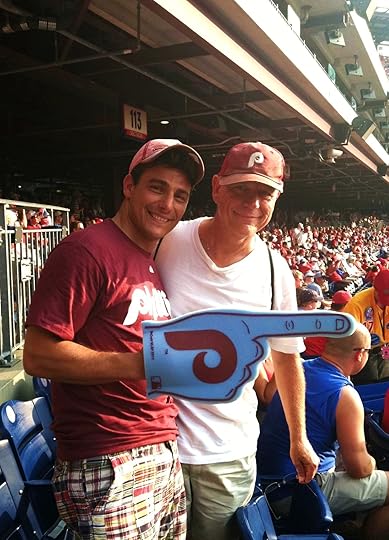
John Hoda and his son
.
If you had to do it all over again, would you change anything about your book?
Sure. I was afraid that the baseball purists would say that I didn’t understand the game. I could have written it with a more wider audience in mind.
.
What genre have you not yet written but really want to try?
Funny you should ask, the one I am working on now is a suspense novel and I am planning a creative non-fiction to follow.
.
If your book would be made into a movie, who should play the main character?
Casey Affleck. Also, I wonder if he is left-handed.
.
How did you get published? Please share your own personal journey.
I wrote the words “The End” for Phantasy Baseball on September 21, 2012. After my beta-readers and critique group told me that the rough draft wasn’t crap, I had to decide to go either traditional or self-pub. I had been reading The Newbies Guide to Getting Published a blog collection by J.A. Konrath and my decision was really a no-brainer.
I knew a great artist, who would do my cover, found the content editor and secured a copy editor as well. I spent some real money on getting the cover right and polishing the manuscript until it gleamed. I lined up E-Book Architects for the formatting and Bookbaby for the aggregating. Then I secured a formatter and CreateSpace did the soft-cover. While the final edits and formatting/aggregating was taking place in the beginning of the year, I began creating my author’s platform with 111Publishing. Phantasy Baseball was then available as an e-Book in early February and in print through Amazon and CreateSpace by the end of the month. I had my official book launch on March 23, 2013 as planned, a week before opening day of the baseball season.
.
What general advice do you have for other writers?
Write the best damn book you can. Don’t be cheap on the cover or on the editing. Realize that you have to promote and market your book if you want your readers to find it, otherwise you will have have an expensive coaster on your coffee table.
.
What do you find is the best part of being an author?
One night at 8 pm, I brewed a cup of caffeine stimulant and let it cool while I started writing. I reached for the cup and it was cold. Strange, I thought. Then I looked at my watch, it was 1am. Five hours went by in a blink of an eye.
.
What is ONE thing that you have done that brought you more readers?
WORKING WITH YOU, OF COURSE!
.
What’s one thing that your readers would be surprised to know about you?
I tried out and won a roster spot on a semi-pro football team as a 46 year-old punter and place kicker.
.
John, thanks a lot for taking the time for this interview. And where can people learn more about your writing and can get your novel Phantasy Baseball?
Phantasy Baseball book trailer: http://www.youtube.com/watch?v=LqnmR9YvzCM
Website: http://www.PhantasyBaseballNovel.com
Online retailers:
Amazon
Barnes&Noble
Apple
Kobo
.
<><><><><>
.
If you would like to get help in all things publishing, have your book heavily promoted and learn how to navigate social media sites: We offer all this and more for only a “token” of $1 / day for 3 months. Learn more about this individual book marketing help: http://www.111Publishing.com/seminar
Please feel free to check out all previous posts of this blog (there are more than 760 of them : ) if you haven’t already. Why not sign up to receive them regularly by email? Just click on “Follow” in the upper line on each page – and then on “LIKE” next to it. There is also the “SHARE” button underneath each article where you can submit the article to Pinterest, Google+, Twitter, Chime.in, Facebook, Tumblr and StumpleUpon.
Thanks a lot for following:
@111publishing
http://pinterest.com/111publishing/
http://bit.ly/VmtVAS 111Publishing @ Google+
.
Tagged: Babe Ruth, Baseball fan, Baseball Novel, Baseball season, Interview with author John Hoda, Major League Baseball, Phantasy Baseball, Phillies







May 29, 2013
Celebration and Gratitude for 200.000 Blog Readers!
.

Celebrating!
.
A big THANK YOU to all my blog readers of the last two years who learned about publishing and book marketing from almost 770 blog posts!!! Today, the 200.000th reader logged into http://savvybookwriters.wordpress.com. A reason to be really grateful! Even if it is only hobby, or better a mission to support author-publishers. Thanks for subscribing, for coming here day for day and for recommending this blog to your friends and fellow writers – or to even re-blog it.
.
Thanks for writing these comments
– of which 99% are praise and encouragement. Sorry to all of you who did not (yet) get a reply: I really appreciate your comments a lot! And I am extremely thankful for such a loyal following. Please bear with me : ) even when I am not answering immediately. I really enjoy writing these tips for authors and if I would have the time, I would write even more, and answer your comments faster.
.
Soon this blog will invite all readers to sign iup for a newsletter
with even more in-dept information and also news of free or
reduced books. Let us know if you want your book promoted
on free KDP days or 99-cent promotions.
.
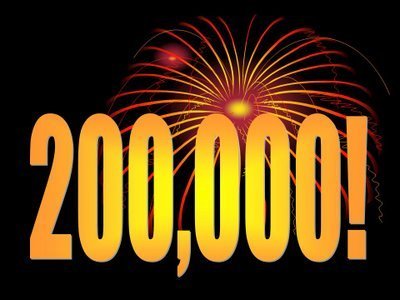
Celebrating 200.000 Readers
.
Again, thanks for subscribing to this blog and for all your comments and your loyalty and I hope, you will gain lots of encouragement from reading these tips and you implement them into your publishing and book marketing career.
Doris
.
<><><><><>
.
If you would like to get help in all things publishing, have your book heavily promoted and learn how to navigate social media sites: We offer all this and more for only a “token” of $1 / day for 3 months. Learn more about this individual book marketing help: http://www.111Publishing.com/seminar
Please feel free to check out all previous posts of this blog (there are more than 760 of them : ) if you haven’t already. Why not sign up to receive them regularly by email? Just click on “Follow” in the upper line on each page – and then on “LIKE” next to it. There is also the “SHARE” button underneath each article where you can submit the article to Pinterest, Google+, Twitter, Chime.in, Facebook, Tumblr and StumpleUpon.
Thanks a lot for following:
@111publishing
http://pinterest.com/111publishing/
http://bit.ly/VmtVAS 111Publishing @ Google+
.
Tagged: 200.000 readers, 765 blog posts







May 28, 2013
99% of All Manuscripts Will Be Accepted …
.
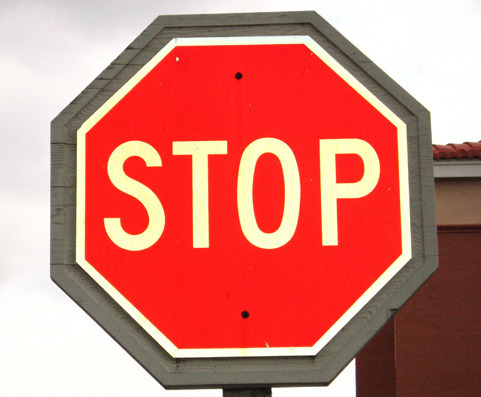
Stop Vanity Publishing
… and will be printed - but only by Vanity Publishers (aka Subsidy Publishers) – as long as the author is willing to pay their totally inflated prices.
The main goal of these vanity publishers is to have their printing company busy, so they are not really into executing the work of a traditional publisher.
A background check reveals in almost all cases that they are either printers or affiliated with a printing company. I learned that even one of the best Canadian book printing companies went into vanity publishing a year ago.
.
You often might have seen these small ads in literary magazines or on the internet: “If your book deserves publication, send your manuscript now to …”. And authors do not have to wait long for a response to their submission.
.
Money upfront
Authors are certainly surprised when they encounter a publisher who wants money up-front. It should be the other way around shouldn’t it? After the author, having signed a hefty check, eventually learns that paying for publication is no guarantee that a single copy of his book will appear in any book shop, not even the local ones.
Many vanity publishers will charge somewhere between $8,000 to $20,000 (or even more) to publish a book depending upon its length. Why would an author pay $20,000 when he or she can have the same book printed for $1,500?
.
Contract full of (empty) promises
Nevertheless, the contract will be full of promises: What exactly will be paid to the author for subsequent reprinting, subsidiary, for audio and e-books, mass-market paperback rights, TV & Radio rights, merchandising and commercial rights and even film and foreign rights – to make the author believing that his “publisher” actively solicits his manuscript in Hollywood.
Vanity contracts include usually a certain amount of “free” copies for the author; sometimes even as much as 10 books and if he/ she require more, they have to be paid. In reality, the author is paying for them twice…
.
The stock of unsold books remains the property of the publisher
so if there is a chance to remainder them later, he cashes the proceeds. In most cases, only a certain number of copies (I suspect not even this will happen) in an edition will actually be bound; the rest will remain in the warehouse as flat printed sheets until required, which is probably never. However the author has paid in advance for complete books!!! And I have never met an author who goes into the print shop / binder to watch his or her books manufactured or to see them stored in the warehouse.
Vanity / subsidy publishers are not concerned with editing, promotion, sales or distribution – unless the author pays additionally. For most vanity books, neither exists, and should review copies really being sent out: Reviewers are wary of vanity presses because they know that little attention is paid to the editing of the book. Unless the vanity house has a proven distribution and sales organization, the author is going to have to sell it himself and usually the book sells fewer than 200 copies.
.
As seen in a Vanity publisher contract:
“In the event of bankruptcy or liquidation of the publisher for any cause whatever, the author shall have the right to buy back the publications at fair market value to be determined by agreement or arbitration.” (That means, die author has to pay a second time for all his unsold books). “If the author does not purchase remaining copies of the book, the representative of the publisher shall have the right to sell same at the best obtainable price without payment of royalty to the author.”
Unbelievable! Unethical! Criminal!
.
Beware of these signs:
Don’t trust flattering letters concerning your manuscript.
Be suspicious of vague promises of quality production. You will not get it in writing…
Be wary of promises to sell television and film rights, serial books and other money-making options.
Read, read and read once more the contract.
Don’t pay a dime, get a copy of the contract and show it to a lawyer that is specialized in contract / copyright law.
Watch out for contract clauses, that allow the publisher to renegotiate his initial pitch, and also where the “Publisher shall have the right to license the rights set forth”.
.
Beside their over-the-top printing prices, Vanity publishers might cheat you in a contract that expires only 50 years after your death and with worldwide rights, even universe rights – a contract that a friend of mine signed in Ontario, Canada (and paid dearly).
“The author hereby grants the publisher, during the full term of copyright, the sole and exclusive right to manufacture, print, publish and sell and to otherwise use, as set out further in this agreement, including, but not limited to, acting as agent and/or exercising any or all subsidiary rights, throughout the universe the work.” And: “The copyright remains with the author, until fifty (50) years after the death of the author. All covenants and grants of the author shall bind the author’s successors or assigns.
.
Vanity Publishers / Subsidy Publishers are not actively promoting books. Their business is not publishing, but printing and selling authors all kind of over-priced services. Despite all these warnings, there are still writers who fall into the trap of vanity / subsidy publishing. And as soon as one vanity publisher goes out of business, another fills the gap.
.
<><><><><>
.
If you would like to get help in all things publishing, have your book heavily promoted and learn how to navigate social media sites: We offer all this and more for only a “token” of $1 / day for 3 months. Learn more about this individual book marketing help: http://www.111Publishing.com/seminar
Please feel free to check out all previous posts of this blog (there are more than 760 of them : ) if you haven’t already. Why not sign up to receive them regularly by email? Just click on “Follow” in the upper line on each page – and then on “LIKE” next to it. There is also the “SHARE” button underneath each article where you can submit the article to Pinterest, Google+, Twitter, Chime.in, Facebook, Tumblr and StumpleUpon.
Thanks a lot for following:
@111publishing
http://pinterest.com/111publishing/
http://bit.ly/VmtVAS 111Publishing @ Google+
.
Tagged: for audio and e-books, mass-market paperback rights, reprinting, subsidiary, subsidy publishers, Vanity Publishers, Writer Beware, Writing contracts








